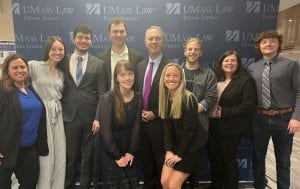-
We Thought it was a Property Problem, but it Turned out to Be a Contract Problem.
By Lauren Thomas

Lauren Thomas, Spring 2023 CDC Fellow, in the UMass Law Library
A ground lease is a long-term commercial lease which typically lasts for 99 years [End Note 1]. With the ability to provide benefits to both landowners and tenants, in recent years, ground leases have gained traction for businesses and investors alike. [End Note 2]. While the process for creating a ground lease seems straightforward enough—draft a contract that is pleasing to both sides and sign—there are oftentimes wrinkles that require careful consideration by both parties. For example, what do you do if contained within the land to be leased is a building which is already being leased to another? And what if the landowner desires that already existing lease to remain in existence for a few more years?
Initially, the presence of an already existing lease on the land could seem to create quite the conundrum. Thankfully though it isn’t a deal breaker and there are several solutions to this otherwise troublesome situation. First, with the permission of the current tenant, the landowner could terminate the existing lease, sign the ground lease, and, so long as it was written in as a condition to the ground lease, require the developer to sign a new lease with the tenant. This however, comes with several risks as it requires not only an early termination of the existing lease, but also because it requires a mutual agreement between the tenant, landowner, and developer, something that each party rightfully might be very hesitant to agree to.
Second, the landowner could choose to hold off on signing the ground lease until the natural termination of the existing lease. This is perhaps the easiest solution depending on how long the term is for the existing lease. However, if the landowner wishes the current tenant to have an option to renew their lease, pushing back that natural termination even further, the landowner may miss out on a great opportunity to enter into a ground lease should the developer not also be willing to wait until the natural termination of the existing lease.
Third, the landowner could include a clause in the ground lease detailing that while the existing lease is not a part of the current ground lease, the ground lease may be amended to include that land at the time of the existing lease’s termination [End Note 3]. In essence, rather than approach the situation as it pertains to property law, the landowner would approach it as it relates to contract law—finding solace in a carefully drafted clause. The amendment would then be included as an exhibit to the ground lease which could easily be finalized and recorded when the time came. [End Note 4].
Which option makes the most sense? Although true that the third option requires a little bit more effort than options one or two, it is safe to say that it also provides the best security for every party involved. The landowner gets to keep their tenant, the tenant gets to keep their lease, and the developer and the landowner get to begin their ground lease.
—
- Michael Allan Wolf, Powell on Real Property §37.26 (2023)
- See generally Monte Mann, Ground Leases Offer Potential Benefits for both Tenants and Landowners, JDSupra, Jun. 9, 2022, https://www.jdsupra.com/legalnews/ground-leases-offer-potential-benefits-7432027/
- See U.S. Securities and Exchange Commission, https://www.sec.gov/Archives/edgar/data/1124610/000119312511208390/dex1026.htm (last visited Apr. 25, 2023).
- See U.S. Securities and Exchange Commission, https://www.sec.gov/Archives/edgar/data/908652/000119312505052626/dex1026.htm (last visited Apr. 25, 2023).
-
Social Security Benefits: An Opportunity to Start Anew
By Justin Taylor

Justin Taylor, Spring 2023 CDC Fellow, in the UMass Law Library
The fear of returning to work is very prevalent for those that collect social security disability benefits. People receiving these benefits often rely heavily on them for their daily care and necessities; the risk of losing that income causes many to stop pursuing the goal of returning to work. However, this fear can be alleviated through the use of certain Social Security Programs that encourage those with a disability to return to work.
Social Security has two different disability programs. First is Social Security Disability Insurance (SSDI), which is the main program under which people receive payments. The second is Supplemental Security Income (SSI) which gives additional payment to individuals with limited income and resources. Both programs offer a unique incentive for those that are recipients of them. These incentives are to encourage people to return to work with peace of mind knowing they will still be covered. Furthermore, if used correctly, they can greatly benefit a person looking to return to work or start their own organization.
The first incentive is the Plan to Achieve Self-Support (PASS) offered under SSI. It can be used to receive additional training and resources necessary to return to work or even provide the requisite knowledge and equipment to start a business. The program is a strong incentive for recipients of SSI to return to work because it allows them to obtain equipment and knowledge that they might otherwise have to pay for out-of-pocket. Without this program, recipients who wish to return to work but lack the skills might not see a viable way of returning to work. Going to work for an able-bodied individual might seem mundane, but for a disabled person gathering the requisite equipment to do so can be rather costly and difficult. Furthermore, a disability might limit the recipient’s career choices and cause them to lose valuable knowledge that they have already gained, thus forcing them to start over in a new career field where learning can also come at a cost. This program alleviates these issues and provides a way for disabled persons to gather everything that is necessary to start working again.
The second incentive is the Trial Work Period. This is an incentive program offered under SSDI that allows a recipient to take a salary even though they might not have the capacity to work full-time in the beginning. The recipient is allowed nine trial months in which they can work for more than $1,050 or over 80 hours and has no impact on their benefits. The recipient has a sixty-month period to use their nine trial months before they start seeing an effect on their benefits. Once the recipient uses their nine trial months, they then enter the next phase of the program. This phase consists of a three-year period in which the recipient will still receive their social security benefits in any month that they do not earn “substantial” [Footnote 1] income. This program is helpful because returning to work full-time can be difficult for a disabled person, and the Trial Work Period allows recipients to freely test their ability to work again without fear of losing their benefits.
The strength of these programs can really be seen for a person receiving both SSDI and SSI because each offers a program that is suited for different stages of returning to work. PASS allows an individual to gain the foundational skills necessary to return to work and can help them gain knowledge without the price of paying for it. Then, once the recipient feels confident in their skills and knowledge, the Trial Work Period allows them to start returning to work part-time or full-time with the knowledge that their benefits will still cover them should their disability make them unable to work again. An attorney understanding these programs and how they can help to achieve a client’s vision of starting an organization or returning to work can help alleviate the fear the client may have and also offer additional support in ways that are not always expected.
—
Footnote 1. Substantial earnings are anything over $1,470 a month.
-
How can a Massachusetts 501(c)(3) organization be exempt from property tax when leasing real property in a ground lease?
By Philip Light

Philip Light, Spring 2023 CDC Fellow, in the UMass Law Library
Property tax represents the largest source of revenue for Massachusetts when compared to any other tax collected at state or local level. [End Note 1]. Nevertheless, there are ways to be exempted from paying property tax, one such way is by being a 501(c)(3) organization. A 501(c)(3) organization also known as a charitable organization is granted special tax exemptions from the Internal Revenue Service (IRS). [End Note 2]. Under certain circumstances such as a ground lease for real property, a 501(c)(3) organization must meet special requirements to qualify for a property tax exemption.
A ground lease also known as a land lease, is when an owner leases their land to another party for long-term, typically 99 years, during which the tenant will develop the land, and at termination of the lease the property will go back to the owner with all improvements. [End Note 3]. A ground lease provides numerous benefits to both the landlord and the tenant leasing the land, including tax benefits. The ground lease can be drafted to make either the landlord or the tenant responsible for specific types of taxes during the duration of the lease. So, what will happen when a Massachusetts, 501(c)(3) organization is drafted to be responsible for the property tax as the tenant of a ground lease?
Massachusetts law allows for a charitable organization that leases property a tax exemption under specific conditions. First the organization must be found as a 501(c)(3) charitable organization recognized by the IRS. A charitable organization is an organization that is a corporation, trust or non-profit established for literary, benevolent, charitable, or scientific or temperance purposes. [End Note 4]. With its principal purpose and activities for the benefit of the public and not limited to certain groups of people. [End Note 5]. Additionally, at any point during operation or if dissolved the organization cannot use its income or assets for non-charitable purposes, nor for the benefit and enrichment of the directors, officers, and shareholders. [End Note 6]. After being recognized as a 501(c)(3) charitable organization under the IRS, the next step is to show that the real property was acquired for a charitable purpose. [End Note 7]. However, even if the organization is found as a 501(c)(3) organization with real property acquired for charitable purposes, the landlord of the lease plays a crucial role in determining if the 501(c)(3) tenant can be exempt from property tax.
If the landlord of the ground lease is a religious organization or another 501(c)(3) organization?
The 501(c)(3) tenant must apply to the local city or town for property tax exemption. [End Note 8]. Exemptions are granted by the town’s assessor’s office; they will check the application and determine if the organization meets the criteria for property tax exemption. [End Note 9]. If criteria are met and they are granted exemption the 501(c)(3) tenant’s property tax for the duration of the lease will be tax exempt.
If the landlord of the ground lease is not a 501(c)(3) religious or charitable organization?
The 501(c)(3) tenant will be required to pay for property tax if the ground lease drafted the responsibility to the tenant. This is due to the fact that the landlord is a taxable individual or entity, making it so the 501(c)(3) tenant will be taxable for the property tax. [End Note 10].
In conclusion, when it comes to property tax exemption as a 501(c)(3) tenant in a ground lease, Massachusetts law allows for the organization to stay tax exempt under specific criteria. By meeting these criteria and applying for the exemption with the local city or towns assessor’s office the organization can save significant money that can be used to develop the land in furtherance of their charitable purpose.
—
- Phineas Baxandall, MA Property Taxes: Who Pays? Recommendations for More Progressive Policies, MassBudget, Feb. (2020), https://www.massbudget.org/reports/pdf/Making%20Property%20Taxes%20Progressive%20(long%20report).pdf
- Exemption Requirements -501(c)(3) Organizations, IRS, https://www.irs.gov/charities-non-profits/charitable-organizations/exemption-requirements-501c3-organizations
- GROUND LEASE Definition & Legal Meaning, The Law Dictionary, https://thelawdictionary.org/ground-lease/
- M. G. L. c. 59, §5, https://malegislature.gov/Laws/GeneralLaws/PartI/TitleIX/Chapter59/Section5
- Taxpayer’s Guide to Local Property Tax exemption, Division of Local Services, https://www.mass.gov/doc/religious-and-charitable-organizations/download
- Id.
- Id.
- Id.
- Id.
- Id.
-
Disability Benefits: Pursuing Independence and Maintaining Financial Security
by Alexandra Rampy

Allie Rampy, Spring 2023 CDC Fellow, in the UMass Law Library
Individuals who receive disability benefits are often hesitant to pursue employment opportunities for various reasons. First, many people collecting disability benefits have health conditions or restrictions that limit their ability to work, resulting in their reliance on the financial assistance these benefits provide. Additionally, many fear that earning an income will reduce their benefits, exacerbating their financial situation. Furthermore, individuals with disabilities generally face more significant barriers to employment, such as discrimination, lack of accommodations in the workplace, and limited job opportunities. Overall, the lack of readily accessible resources designed to assist people with disabilities in finding or creating employment opportunities only adds to their reluctance to pursue such opportunities. Attorneys, especially those who work with nonprofit organizations, could benefit greatly from having a general understanding of how the Social Security Administration (SSA) regulates disability benefits when a beneficiary either works for or starts a nonprofit organization.
The SSA distributes disability payments through two programs – Social Security Disability Insurance (SSDI) and Supplemental Security Income (SSI) – the largest Federal programs assisting individuals with disabilities. SSDI pays benefits to workers with a qualifying disability who are “insured,” meaning they have worked recently and long enough and paid Social Security taxes on their earnings. On the other hand, SSI distributes benefits to those with a qualifying disability who have limited resources and income. Eligibility for these programs is evaluated by state Disability Determination Services (DDS), a division of the Massachusetts Rehabilitation Commission contracted and fully funded by the SSA. Additionally, Massachusetts has a disability benefits program called the State Supplemental Program (SSP), which also distributes monthly payments to eligible individuals. Whether a disabled Massachusetts resident qualifies for SSP payments is determined by SSI eligibility; even if a person is above the income requirement for SSI, they may be eligible for partial benefit payments from the state. Navigating the different programs, eligibility requirements, and complex relationships between state and federal regulatory agencies administering these benefits is no simple feat. For many individuals who rely on their disability benefits, financial security is a particularly critical factor when considering employment opportunities.
Could creating a nonprofit corporation in Massachusetts impact an individual’s disability benefits? When a disability beneficiary creates a nonprofit corporation, their SSI benefits could be affected mainly through earnings considered Substantial Gainful Activity (SGA) by the SSA. The impact on SSDI benefits depends primarily on the nature and extent of their involvement with the nonprofit corporation.
The SGA Earnings Guide provides that if a beneficiary’s countable earnings are over a certain amount from work or self-employment, their social security disability benefits may be reduced or stopped. This amount changes yearly, but for 2023, the monthly earnings limit is $1,470 for non-blind disabled individuals. Therefore, if a person receiving disability payments creates a nonprofit and earns an income, this income will likely count towards the earnings limit. If the amount of income from their work exceeds the SGA limit, then they are no longer eligible to receive disability benefits. However, there are some exceptions. If there is evidence that an individual receiving SSI payments is engaging in SGA (*not covered by an exception or regulated incentive program, see “Social Security Benefits: An Opportunity to Start Anew”) or that they are able to control when or how much they are paid, the SSA will evaluate the work activity under the test of comparability and the test of worth work. Under the test of comparability, if the work being performed is essentially the same in quality and quantity as that of an unimpaired individual as their means of livelihood given the circumstances, regardless of the amount of earnings of the impaired person, it must be considered SGA. If the work would not be regarded as substantial or gainful under the comparability test, it may still be considered SGA if the work performed is clearly worth more than the SGA amount per the pay scales of the community. Nevertheless, the SSA’s Program Operations Manual System (POMS) states that after reviewing the facts and circumstances surrounding the individual’s work history, if there is “any reasonable doubt as to whether an individual engaged in SGA under the tests of comparability or worth work, the adjudicator should generally conclude the individual did not engage in SGA.”
In general, maintaining SSDI benefits is based on an individual’s inability to work due to their medical condition. If creating a nonprofit provides an employment opportunity for the beneficiary that they are able to perform, the SSA may determine that they are no longer eligible for SSDI. Furthermore, if the beneficiary receives compensation for their work, this income may also impact their eligibility for SSDI benefits. In practical application, a beneficiary may need to limit their involvement in forming a nonprofit corporation, so the SSA does not consider them to have employment opportunities or make an income. For example, if the beneficiary’s involvement is minimal, such as serving on the board of directors but not actively participating in meetings or decision-making, their benefits will certainly not be impacted. However, if the beneficiary is actively involved in the operations of the nonprofit by serving on the board of directors, working as an employee of the nonprofit, or receiving compensation for services provided, their benefits may be affected.
Navigating the provisions and regulations regarding disability benefits can be complex. Therefore, it is crucial for attorneys and disability beneficiaries alike to understand the impact creating a nonprofit corporation may have on social security disability benefits. Similarly, it is essential for attorneys assisting beneficiaries seeking to create nonprofit corporations to understand the client’s specific circumstances. In conclusion, with prudent planning, a beneficiary can create a nonprofit that helps the community and their own financial situation while preserving their eligibility for indispensable social security disability benefits. Ultimately by being aware of applicable regulatory policies, various exceptions, and incentive programs offered by the SSA, a beneficiary can achieve independence and give back to their community while maintaining financial security.
-
Fiscal Sponsorship- An Alternative to Non-Profit Organization
By Hadassah Gomez

Hadassah Gomez, CDC Fellow Spring 2023
Charitable organizations are often born out of passion, goodwill, a desire to advance a worthy cause and make a positive contribution to society. Unfortunately, these virtuous aspirations are often stifled by the tedious, expensive, lengthy, and complicated legal process of registering as a non-profit. Under the Internal Revenue Code 501(c)(3), (non-profit) status applies to organizations that are organized and operated exclusively for charitable and other specified purposes. A charitable cause or project stands to benefit from non-profit status through tax exemptions, grant eligibility and increased legitimacy which all control the ability to secure funding and efficiently manage the organization’s finances. Charities are a unique business entity, in that they are motivated by altruism as opposed to profits, and they depend on donations, grants and other forms of philanthropic funding, therefore, it is imperative that a charitable organization seeks optimum financial efficiency.
Unfortunately, the non-profit registration process is a legal bureaucracy, likely to deter even the most impassioned organizers of charitable causes. Between state and IRS filing fees, applications for non-profit status can cost upwards of $1000 and take up to six months to be approved. In addition to the application process being pricey and lengthy, it involves extensive and complex paperwork which may necessitate the enlisting of legal or other professional assistance thus adding even more to the expense and wait time.
In this case, what options do charitable ventures have? Must they succumb to the legal bureaucracy that is filing for non-profit status, or do they forego the invaluable benefits said status provides?
The answer to each of the aforementioned questions may be found in a Fiscal Sponsorship Arrangement.
According to the National Council for Non-Profits, a fiscal sponsorship arrangement offers a way for a cause to attract donors even when it is not yet recognized as tax-exempt under Internal Revenue Code Section 501(c)(3). In such an arrangement, a non-profit organization may agree to serve as a fiscal sponsor by providing fiduciary oversight, financial management, and other administrative services to support the activities of charitable entities engaged in work that furthers the fiscal sponsor’s mission. Essentially, an entity that is not officially registered as a non-profit, may still reap the benefits of the status by aligning with an appropriately registered entity. Under this arrangement, the fiscal sponsor assumes legal and financial responsibility for the unregistered sponsored organization. The sponsor may apply for grants and fundraise on the sponsored entity’s behalf. The sponsor may also handle administrative services such as bookkeeping and providing donor receipts for tax-deductible contributions made in the name of the sponsee. This arrangement not only benefits entities that find it impractical to file for non-profit status, it is equally convenient for entities that have filed or plan to file for non-profit status but need operational assistance in the interim.
Similarly, temporary charitable projects that are meant to be short-lived and only exist through the completion of a one-off project, event, or task may find filing for non-profit status impractical. In these cases, a fiscal sponsorship arrangement may be an appropriate solution.
At face value, a fiscal sponsorship arrangement appears to disproportionately benefit the sponsored organization, however, the fiscal sponsor also stands to benefit from said relationship. A fiscal sponsorship arrangement is typically between parties with similar or aligning missions, therefore, the fiscal sponsor is able to extend its reach and further its mission through the work of the sponsored organization. The sponsor may also be able to achieve some of their organizational goals, such as diversity efforts, through the work of the sponsored organization. Where the sponsored organization would have otherwise been a “competitor” of the fiscal sponsor, the arrangement effectively eliminates the competition through collaborative effort. The fiscal sponsor may also leverage the relationship with the sponsored organization for publicity and increased notability. Lastly, the fiscal sponsor may also financially benefit as it is common for a fiscal sponsor to ask administrative and other fees in exchange for the services provided under the arrangement.
Even though a fiscal sponsorship arrangement is an exceptional alternative to registering as a non-profit, there are some downsides that both parties to the arrangement should consider. For the sponsored organization, there is the risk of losing autonomy as the arrangement by nature cedes some degree of control to the sponsor. Furthermore, there is the risk that the sponsored organization may neglect its duties, misuse funds, or otherwise act inappropriately.
For the sponsor, some disadvantages include exposing itself to reputational risk. Even if the fiscal sponsor diligently vetted the sponsored entity prior to entering the arrangement, there is no guarantee that the missions of both parties will always align, and that any controversy associated with the sponsee would not affect the sponsor given their affiliation.
It is also important to note that a fiscal sponsorship arrangement may be governed by some sort of agreement. It is imperative that both parties contractualize the relationship to clearly define what is expected of each party. The agreement may also be comprehensive enough to include the extent of either party’s authority, the expectations for financial management, the procedure for terminating the agreement and the method of dispute resolution in the case of conflict.
In conclusion, a fiscal sponsorship is a valuable technique to circumvent the non-profit registration process, while still being able to access the benefit of non-profit status. Altruism need not die at the hands of legal bureaucracy and fiscal sponsorship might just be a lifesaver for some charitable agendas. Acknowledging that the arrangement has inherent risk, parties may protect their respective interests through a well-executed Fiscal Sponsorship Agreement. Therefore, charitable entities in the start-up or pre-registered phase may benefit from considering Fiscal Sponsorship as a vehicle to access non-profit benefits without going through the hurdle of non-profit registration.
-
Brand Protection in the New Age of E-Commerce
By Madison Boudreau

Madison Boudreau, CDC Fellow Spring 2023, pictured in the UMass Law Library
The rise of and development of e-commerce over the last nearly thirty years has completely revolutionized consumerism and shifted the retail industry from what it once was. The inception of the “digital marketplace” in the United States can be dated back as far as 1982 upon the launch of the Boston Computer Exchange, an online platform for the purchase and sale of used computers. However, it was not until the development and growth of sites like Amazon and eBay in the nineties that the online retail industry would truly begin to take shape. Despite the initial “burst” of the dot-com bubble in the early 2000s, the last two decades have shaped digital dominance worldwide—and retail is no exception. Between 2015 and 2019, the e-commerce share of total global retail sales experienced steady annual growth over the four-year period, rising from 7.4% to 13.6% during this time.
The COVID-19 pandemic sparked an increase in online retail engagement by necessity, which led the e-commerce share of total global retail sales to jump from 13.6% in 2019 to 18% in 2020. Between 2020 and 2022, Americans spent $1.7 trillion online, representing a 55% increase in digital spending compared to the two years preceding the pandemic. Further, in response to the personal and financial hardships that resulted during this period, there seemed to be a boom in e-commerce innovation. According to the U.S. Census Bureau’s Business Formation Statistics, there were more applications filed to form new businesses in 2021 (5.4 million) and 2022 (5.1 million) than any other year on record. The culmination of these circumstances has led to a fundamental shift in the consumerism paradigm as a whole.
In many respects, the e-commerce boom over the last three years in particular has streamlined small business ownership—particularly for retail businesses. In 2023, it is not uncommon for small retail businesses to operate exclusively online; many of whom operate exclusively as third-party sellers for websites like Amazon, Shopify, and Etsy. Further, the increased role of curated social media in consumer advertising provides an opportunity for these small retailers to build brand identity for little to no cost and with potential for exponential growth and limitless market reach. As a result, this new age of e-commerce has created the image that small business ownership has never been easier. While there may be some truth to this façade, it is equally true with the rise of modern digital retail comes its own unique set of risks and challenges—namely in the wheelhouse of intellectual property.
Trademark registration has long been recognized as an invaluable tool for distinguishing brands from one another. The protection offered to trademarked symbols or words is intended to provide notice of claim to other businesses, a legal presumption of ownership, and the exclusive right to use the trademark. However, characteristics of the modern global online marketplace have revealed deficiencies in trademark law as it stands today. In short, the oversaturation of the market has made it difficult for small business owners to navigate the possible risks, rights, and remedies under the current trademark framework.
First, the determination of eligibility of a certain mark for trademark protectio
n is a lengthy process that can take an average of 12-18 months for finalization and legal recognition. Further, the sheer size of the online marketplace has made it more difficult than ever for small business owners to stay afoot of marks in use by other brands. As a result, e-commerce retailers may unknowingly lack proper protection of their brand before the trademark registration process has been completed or may expose themselves to liability by using symbols or words already registered and protected.
Additionally, the third-party sale of retail through websites like Amazon, eBay, and Etsy raises new questions surrounding the contributory liability of these online marketplaces for trademark infringement. This concept of “secondary liability” has been judicially created and has continued to evolve alongside this new age of e-commerce. In Tiffany Inc. v. eBay, Inc., the Second Circuit established that trademark owners have the burden of policing their trademarks in online marketplace websites, where online marketplace website owners provide an adequate process to remove potentially infringing listings once reported. More than a decade later, courts remain undecided on the proper framework for these cases.
While the impact of the post-pandemic digital age on business ownership and structure has provided increased accessibility for people to start and run their own enterprises, the new legal risks related to brand identity this landscape has fostered should not be understated. As the consumerism paradigm continues to shift throughout this time, it is of utmost importance to remain mindful of these new considerations to adequately advise small business owners for success in the new age of e-commerce.
-
What is a Fiscal Sponsorship Agreement and Do You Need One?
By Austin Gutierrez

Austin Gutierrez, Community Development Clinic Fellow Spring 2023, pictured in the UMass Law Library
Fiscal Sponsorship Agreement’s (FSAs) are an effective way of starting new nonprofits, social movements, and providing public services. (i). These FSAs are fairly common within the realm of nonprofits. In general, a fiscal sponsorship means that a nonprofit organization, the “fiscal sponsor”, agrees to provide administrative services and oversight to, and assume limited legal and financial responsibility for, the activities of groups or individuals engaged in work that furthers the fiscal sponsor’s mission. (ii).
Typically, when seeking out a fiscal sponsor, the situation is where someone with a new charitable venture or program idea has a relationship with an existing 501(c)(3) organization/public charity, and that organization facilitates the raising of grants and donations for the project. (iii).
There are numerous ways to create an FSA but the majority of the FSA’s fall into three different categories: Model A, Model B, and Model C. Model A and Model B generally entail the fiscal sponsor having total ownership/control over the project being sponsored. (iv). The people who want to create the idea go to the sponsor and under a Model A agreement, those who had the idea are typically the employees of the now fiscal sponsor. Model B is similar, but those with the idea will be overseeing the project as independent contractors instead of as employees like in Model A. (v). Between both these models, the project is ran as if the fiscal sponsor is operating the project.
There is a grantor-grantee relationship that is referred to as Model C. Here, the fiscal sponsor has a more limited role. (vi). They are just receiving funds for the project and making grants to the sponsored organization/project. So instead of having total control of the program, the fiscal sponsor has a more “hands-off” approach.
In all of these versions of a FSA, it is important to recognize that the fiscal sponsor ultimately has control of where the funds go for the sponsored project/organization. (vii). This is typically referred to as a variance power. This is where the fiscal sponsor has discretion and control of what happens with the money.
Organizations would consider fiscal sponsorship when they cannot do the project on their own. The variance power is the “trade-off”. (viii).
The benefit of aligning with a fiscal sponsor is typically because these new projects/organizations don’t usually have 501(c)(3) status. That means, without a fiscal sponsor, the project/organization does not have that immediate access to grant funding from private foundations, government grants, nor tax deductible donations. (ix). This is the benefit the fiscal sponsor provides along with the capacity benefit. Capacity referring to the staffing, administrative expertise, typically know-how of the work environment, and experience the new project generally does not have. (x).
The “trade-off” is that the new project/organization is giving up control, a fee of 3-5% on the low end or 15% on the high end. (xi). Without the variance power, the fiscal sponsor is nothing more than, as the IRS states, a “conduit”. (xii). They are just receiving money and passing it along without exercising any control in-between. This would cause consequences for the fiscal sponsor and jeopardize the deductibility of the contributions offered. Parties must know and understand this trade-off.
Generally, fiscal sponsors are not made to continue “forever”. So, when a project is successful and works well, that sponsored organization/team will typically go off and form their own organization independent of the fiscal sponsor. Use the knowledge that they’ve gained from the experience of the sponsorship and hopefully go on their own after.
Fiscal Sponsorships also work well for the fiscal sponsor when the project does not go as well as they would have hoped. Typically, this can be seen as a test run for the fiscal sponsor and it is easy to “give up” on because they can just shut down the project if it is unsuccessful. (xiii). One concern, if you are looking to get sponsored, is to vet or at least assure that the possible fiscal sponsor is actually able to provide administrative support. (xiv). There have been situations where fiscal sponsors take on too many projects and leave those seeking to get funded on the backburner.
When fiscal sponsorship comes to an end, many fiscal sponsors believe they have a lot more rights than they actually do. Due to the fiscal sponsor’s variance power, the fiscal sponsor has the final say on where the money goes at the end of the relationship. (xv). Typically, the project/organization does not get a say on where the raised money ends up, this is at the discretion of the fiscal sponsor. (xvi). To avoid these awkward situations, one can hopefully establish some planning in the initial agreement when the termination occurs, be that final expenses or other termination matters. But generally, the fiscal sponsor should have the final say in what happens to the funds come the termination of the agreement.
On a final note, some FSAs provide a provision that establishes after a certain amount of time, the parties will regroup and reassess the agreement as the project has evolved. (xvii). This allows both parties the option to re-negotiate the agreement and see if they want to “renew” the agreement or part their separate ways. This provision encourages cooperation between the two parties and builds an expectation that the parties will plan their next steps and if it is appropriate to continue.
——————–
(i) Guidelines for Pre-Approved Grant Relationship Fiscal Sponsorship, Nat. Net. Fis. Spon. at 1,https://static1.squarespace.com/static/5e5e9444031f011bf0e6a0f8/t/5ee917ad16f2fa739ca32b8c/1592334254300/NNFS+Guidelines+for+Pre-Approved+Grant+Fiscal+Sponsorship.pdf
(ii) Id.
(iii) Benjamin Takis, Q&A #71 – What’s the difference between model A and Model C fiscal sponsorship?, Se4., Aug. 4, 2021, https://www.se4nonprofits.com/blog/qa-71-whats-the-difference-between-model-a-and-model-c-fiscal-sponsorship
(iv) Michael Gellman & Benjamin Takis, Video: Fiscal Sponsorship Basics for Nonprofits, Se4., Dec. 17, 2021, https://www.se4nonprofits.com/blog/video-fiscal-sponsorship-basics-for-nonprofits
(v) Id.
-
Why Should a Company Trademark Its Logo?
By Laurie Miller

Laurie Miller, CDC Fellow Spring 2023, pictured in the UMass Law Library
I recently saw the movie “Air” which is the true story of Nike’s signing of basketball legend Michael Jordan in 1984. Nike was floundering at the time, but the Air Jordan basketball shoe promotion was Nike’s most successful marketing campaign ever, responsible for $100 million in revenue for Nike in its first year alone. At the center of it all is the trademarked logo that Nike still uses today – Michael Jordan jumping in the air with his outstretched hand gripping a basketball, his legs spread wide apart, and, of course, the distinctive Air Jordans on his feet. This logo celebrates Michael Jordan’s athleticism, his greatness and his uniqueness and is an extremely important intellectual property asset to Nike to this day.
Trademarks are very important to brand identity, so obtaining federal trademark protection is imperative to successful marketing and promotion of a product. Consider if Nike hadn’t trademarked the Air Jordan logo. Other athletic product companies could have copied that trademark to market their products – imagine a logo of Patrice Bergeron jumping into the air in a pair of Bauer hockey skates or a logo of Rob Gronkowski jumping into the air in Adidas football cleats. Had Nike not taken the necessary steps to protect their logo, they could have lost an important marketing edge that they gained back in 1984 when they designed the Air Jordan logo.
Trademarking a logo can be a long and arduous process, but one that is necessary to insure adequate legal protection for the company’s intellectual property. There is a lengthy and detailed application to file with the United States Patent and Trade Office (USPTO) along with an application fee of $275-$660. Once you file your application with the USPTO, it will be approximately fifteen months to obtain approval from the USPTO. During this time, USPTO will be reviewing your logo and comparing it to other registered logos and also against logos that are still pending (which therefore, haven’t been formally published in the trademark register) and trying to determine if your trademark could be confused with someone else’s trademark.
The USPTO primarily examines two factors in its determination of the likelihood of confusion between an applicant’s mark and a mark previously registered or pending registration: (1) the similarity of the marks in their entirety, and (2) the relatedness of the goods or services provided. The USPTO also looks at whether the marks are sufficiently similar in terms of their commercial impression such that consumers who encounter the marks would be likely to assume a connection—not whether the marks are distinguishable from one another when side-by-side. Therefore, the more similar the marks, the more similar the goods or services of those individuals or entities must be in order to support a finding by the USPTO that the marks are likely to cause confusion.
It is important to properly trademark any logos which you have been using as part of your marketing promotions. Having a solid understanding of the criteria used by the USPTO to differentiate logos will aid you in designing a logo which will reflect the ideals and aspirations of your product. Remember, properly trademarked logos can save your company money, time and headaches and just make good business sense.
-
CDC Hosts Mayor Mitchell of New Bedford for Community Development Lecture
The Community Development Clinic was honored to host Mayor Jon Mitchell this month at the Community Development Lecture at UMass Law. The lecture was followed by a reception.
Throughout his term in office, Mayor Mitchell has sought to re-establish New Bedford as one of the leading cities in the Northeast. He has moved aggressively to reform the city’s schools, improve public safety, modernize the port, and to elevate the quality of life in every neighborhood. Under Mayor Mitchell’s leadership the City has achieved both the highest bond rating and highest high school graduate rate in its history, lowered crime by nearly forty percent, secured hundreds of millions of dollars in investment, and positioned itself to become the leader in the emerging offshore wind industry. Mayor Mitchell graduated from Harvard College and the George Washington Law School. Before running for Mayor in New Bedford, Mayor Mitchell was also an Assistant United States Attorney in Boston, having previously served as a federal prosecutor in Washington, D.C. in the Attorney General’s Honor Program.
Hosting Mayor Mitchell for a lecture on community development and law was an excellent way to learn more about important issues related to legal and social justice local to UMass law students. A knowledgeable and experienced speaker, Mayor Mitchell provided valuable insights and perspectives on topics such as how law and policy affect communities, strategies for promoting community development, and approaches to addressing social and economic inequalities. For UMass Law students involved in law and social justice, this event broadened understanding of local legal and social justice issues.
During the lecture, Mayor Mitchell spoke at length about New Bedford’s emerging leadership role as a producer of offshore wind energy, along with the complex legal and political frameworks that accompanies such developments. The development of offshore wind energy requires navigating complex legal frameworks at both the national and international levels, as well as addressing environmental concerns, energy policy, and economic considerations. Laws and regulations related to the permitting, construction, and operation of offshore wind projects must be carefully crafted to ensure that they balance the needs of various stakeholders, including developers, governments, and communities. Moreover, the development of offshore wind energy has the potential to create jobs and stimulate economic growth in the areas where the projects are located. The legal frameworks around offshore wind energy are constantly evolving, as governments and stakeholders work to find the best ways to promote the growth of this important renewable energy source while also protecting the environment and addressing social and economic issues. UMass Law looks forward to further partnerships with the area’s entrepreneurs and social change makers as this sector grows.
- From Top Left: Crystal Desirey, Madison Boudreau, Philip Light, Justin Taylor, Mayor Jon Mitchell, Andrew Ashkar, Laurie Miller, Austin Gutierrez From Bottom Left: Prof. Lisa Lucile Owens, Alexandra Rampy
- DJ Bishop of the Bish Strong Foundation introducing Mayor Jon Mitchell of New Bedford at the UMass School of Law Community Development Lecture
- Mayor Jon Mitchell Delivering the Community Development Lecture at the UMass School of Law, April 2023
- Laurie Miller asking a question following Mayor Jon Mitchell’s Address at the Community Development Lecture at UMass School of Law
- DJ Bishop of the Bish Strong Foundation, Justin Taylor and Allie Rampy Following the Community Development Lecture at UMass School of Law
- Mayor Jon Mitchell & Prof. Lisa Lucile Owens following the Community Development Lecture at UMass School of Law
- Andrew Ashkar discussing The Community Development Lecture with Mayor Jon MItchell of New Bedford
-
Ground Leases: Private Contracts for the Public Good
By Nicole Egan

Nicole Egan, CDC Fellow Fall 2022
Property values have doubled in the past twenty years (i), and recently, mortgages hit their highest rate in a decade (ii). These rising costs have led to substantial declines in home ownership statistics because potential buyers are priced out of the market. (iii) Unfortunately, despite being portrayed as a modern trend, housing affordability crises are nothing new. Throughout history, land ownership has always been a source of wealth reserved for a lucky and disproportionate few (half of the land in England, for instance, is still owned by less than 1% of the country’s total population) (iv). To be fair, inequalities in land ownership do make sense. Land is humanity’s most valuable resource: providing food, water, shelter, and enjoyment for people who are unable to simply make more of it.
However, as lucrative as land ownership may be, merely having the right to use it can be equally as desirable. Large corporate retailers, for example, frequently agree to build and operate businesses on land they do not own. The advantages of doing so are clear—instead of purchasing expensive property, a land Tenant simply pays rent while Landlord-Landowners profit on otherwise unused land. Upon expiration of the contract, the right to possess the property returns to the landowner, leaving the Tenant free to pursue their next business venture without being tied to the land. But agreements like this are not confined to commercial transactions—anyone fortunate enough to hold vacant property can temporarily assign their rights by entering into a Ground Lease.
A Ground Lease is defined as a “long-term (usually 99-year) lease of land only. Such a lease typically involves commercial property, and any improvements built by the lessee usually revert to the lessor ” (v) In other words, in a Ground Lease, individuals or entities retain title to their land while another party has the right to enter, possess, and use it for any agreed-upon purpose (vi). In general, there are two types of Ground Leases (vii). In a subordinated Ground Lease, the Tenant’s bank usually receives a security interest in the property when it is used as collateral in a loan (viii). This poses a risk to Landlords because their land may be subject to repossession in the event of a default by the Tenant. On the other hand, in an unsubordinated Ground Lease, Landlords maintain superior rights for all claims against their land—so even if a Tenant defaults on a construction loan, the Landlord still maintains ownership of their property in an unsubordinated Ground Lease (ix).
Of course, as with any contract, there are certain risks that must be anticipated before signing. One common issue is that Ground Leases are often entered into during the early stages of ambitious construction projects—frequently before a Tenant has received all required zoning and building approvals (x). Thus, there may be no guarantee that a new business will actually ever open its doors in the event a Tenant is unable to obtain all of the permits necessary to begin construction. Moreover, even if a commercial Tenant is able to build and subsequently run a profitable organization, there’s always a risk that the business may not be sustainable.
Nonetheless, issues like this can be prepared for by drafting periodic reappraisal options into the lease for the Landlord’s benefit (xi). This provision allows for landowners to request periodic reassessments of their property’s value in order to renegotiate rent payment amounts or other applicable lease terms to protect their investment over time (xii). Additional considerations like insurance liability and coverage, duration, and defined business purposes should also be drafted into the agreement to clarify ambiguities and avoid disagreements down the line. But in essence, Ground Leases allow landlords to avoid typical lessor risks and obligations while securing rental income for a set duration.
Accordingly, Ground Leases should be used to provide affordable housing opportunities. An unsubordinated Ground Lease could potentially provide public housing facilities, owned and operated by Non-Profit companies that cannot afford to purchase land outright in pursuit of their cause. In that example, the landowner benefits by receiving rent payments while also providing an urgent public need for housing, all the while knowing that their land will likely increase in value over time anyway. As long as the Non-Profit Ground Lease Tenant has the experience and qualifications necessary to turn their dreams into a reality, all the landowner needs to do is patiently wait to collect on their investment.
In sum, Ground Leases are tools by which individuals or entities who cannot afford to purchase real estate via traditional financing methods can still possess and use land, just like a titleholder would. Unlike in typical rental agreements, Ground Leases allow tenants to build and use land for any agreed-upon purpose. Additionally, Landowners may lease their property for profit while waiting for its value to increase over time. Therefore, Ground Leases could help rebalance inequalities in the housing market—and all landowners need to do is sign.
——————–
i Nick Routley, Charting 20 Years of Home Price Changes in Every U.S. City, VISUALIST CAPITALIST, Oct. 22, 2020, https://www.visualcapitalist.com/20-years-of-home-price-changes-in-every-u-s-city.
ii Thomas Yeung, Housing Crisis 2022: 3 Graphs That Show How Wild Home Prices Have Become, INVESTORPLACE, Oct. 13, 2022, https://investorplace.com/2022/10/housing-crisis-2022-3-graphs-that-show-how-wild-home-prices-have-become.
iii 2022 State of the Nation’s Housing Report, HABITAT FOR HUMANITY, https://www.habitat.org/costofhome/2022-state-nations-housing-report-lack-affordable-housing.
iv Rob Evans, Half of England is Owned by Less Than 1% of the Population, THE GUARDIAN, Apr. 17, 2019, https://www.theguardian.com/money/2019/apr/17/who-owns-england-thousand-secret-landowners-author.
v LEASE, Black’s Law Dictionary (11th ed. 2019) (emphasis added).
vi See Jonathan Stein, Tax Considerations for Ground Leases, GOULSTON & STORRS, Feb. 22, 2022, https://www.goulstonstorrs.com/publications/tax-considerations-for-ground-leases (stating that ground leases usually last from 25-99 years and are preferred by property owners who are underutilizing their land).
vii See Jeri Frank, What Are Land or Ground Leases and How Do They Work? STRATAFOLIO, Jun. 17, 2020, https://stratafolio.com/what-are-land-or-ground-leases-and-how-do-they-work (describing the benefits of unsubordinated and subordinated ground leases).
viii Id.
ix Id.
x See Jerome D. Whalen, Six Things You Should Know About Ground Leases, 33 No. 3 Prac. Real. Est. L. 19 (2017).
xi Id.
xii Id.






